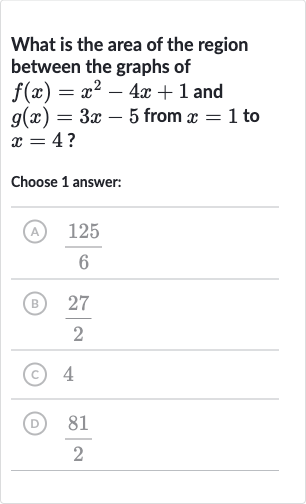Full solution
Q. What is the area of the region between the graphs of and from to ?Choose answer:(A) (B) (C) (D)
- Define Area Integral: To find the area between two curves, we need to integrate the difference of the functions over the given interval. The area is given by the integral from to of .
- Find Difference of Functions: First, we need to find the expression for . We have and . So, .
- Simplify Expression: Simplify the expression for . This gives us .
- Set Up Integral: Now we can set up the integral to find the area : .
- Calculate Antiderivative: Calculate the integral of with respect to from to . The antiderivative of is , the antiderivative of is , and the antiderivative of is . So the integral becomes: from to .
- Evaluate Limits: Evaluate the antiderivative at the upper limit of integration and then at the lower limit of integration , and subtract the latter from the former. This gives us .
- Perform Calculations: Perform the calculations for each term. For , we have . For , we have .
- Simplify Results: Simplify the calculations. For , we have . For , we have .
- Subtract Values: Subtract the value at from the value at to find the area . This gives us .
- Convert to Improper Fraction: Convert the mixed number to an improper fraction to get the final answer. The area .
More problems from Operations with rational exponents
QuestionGet tutor help
QuestionGet tutor help
QuestionGet tutor help
QuestionGet tutor help
QuestionGet tutor help
QuestionGet tutor help

